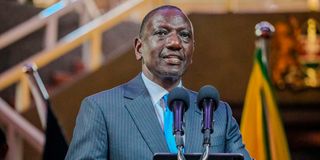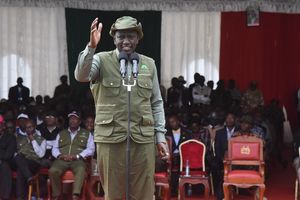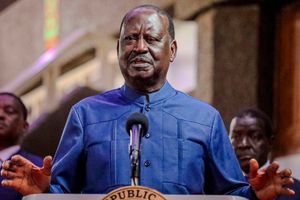
President William Ruto addresses journalists at KICC, Nairobi on July 9, 2024.
The body language was telling. President William Ruto looked pained and lonely as he announced the decision to sack his entire Cabinet. It was clear it was not something he enjoyed doing, but pressure from the Gen Z revolt and indications that his administration had become widely unpopular across all demographics and all regions, including those that voted solidly for him in 2022, made the radical decision necessary for his own political survival.
While the sacking was widely lauded, Ruto must also be aware that it is not the answer to the vexing questions that have engulfed a presidency not even two years old. Ruto has his back against the wall, and there is every possibility that far from easing off, the young protesters who have humbled him in ways unimaginable just a few weeks ago will ramp up the pressure. They have smelt blood.
The President, in his statement announcing the sackings, said that he would reconstitute the Cabinet after “consultations across different sectors and political formations, with the aim of setting up a broad-based government”. Essentially, he will be talking to the opposition looking to appoint national unity government incorporating the opposition Azimio alliance led by his nemesis Raila Odinga.
Gen Z movement
The problem is that the Gen Z movement that has forced Ruto into major capitulation is not interested in any power-sharing arrangements amongst the political classes. Not too long before Ruto’s Cabinet bombshell, Raila had been forced to beat a hasty retreat in the face of intense pressure over his stated willingness to engage the President in dialogue. The ‘leaderless, partyless, tribeless’ Gen Z youth skewered the veteran opposition chief for apparently being eager to cut political deals that didn’t address burning national issues, but only offered the beleaguered president a lifeline. It was actually natural that Raila be present at the event where Ruto signed into law the new Act of Parliament for reform of the Independent Electoral and Boundaries Commission.
It was one of the outcomes of the national dialogue process the opposition chief forced Ruto into establishing following months of bloody streets protests across the country in the wake of the 2022 presidential election loss.
Ruto usually assents to new laws in low-key ceremonies at State House, but this time sought to milk political capital by moving the event to the Kenyatta International Convention Centre, and making sure he was flanked by key opposition leaders. Reconstitution of the electoral management body was one of the demands pushed by the Gen Z movement so that they could initiate the campaign for recall of Members of Parliament who had voted for the Finance Bill 2024, whose contentious taxation proposals had ignited the protests.
It should have been a win-win situation, but antennae were raised when Ruto and Raila revealed that they’d already talked agreed on the convention of a national dialogue due to be held over six days the following week. There were also hints that the outcome might be a government of national unity incorporating Raila or his opposition nominees.
The youth were outraged, for they saw Raila, the acknowledged master of protest politics, getting into a political deal that essentially sidelined their protest movement, and relegating the issues that brought them into the streets to the back burners. A social media campaign swiftly went hammer and tongs at Raila for allegedly seeking to secure a place on Ruto feeding trough at expense of the Gen Z protests.
Azimio also suffered a setback when Wiper Party leader Kalonzo Musyoka, who was also at the KICC ceremony as the opposition co-chair of the National Dialogue Committee, Nadco, alongside National Assembly Majority Leader Kimani Ichung’wah for Kenya Kwanza, left the venue immediately after the signing, later disowning the Ruto-Raila dialogue deal. With other Azimio principals – Raila’s 2022 running-mate Martha Karua of Narc Kenya, former Defence Minister Eugene Wamalwa of DAP and Jeremiah Kioni of former President Uhuru Kenyatta’s faction of Jubilee Party – also having kept away, the push for conversation towards a form of unity government was reduced to an ODM-Kenya Kwanza affair.
Raila’s stellar record
The backlash was instantaneous, with Raila being denounced both by his Azimio partners and the youth movement behind the protests. Initially, ODM loyalists were mobilised to push back, defending Raila’s stellar record in the arena of protest politics and his right to engage Ruto without having to seek assent from a nebulous movement with no structures or leadership.
But after a visit from a delegation of some of the younger ODM legislators led by Nairobi Senator Edwin Sifuna, Raila stepped back, coming with a post of X: “I have been told by these leaders that you said you don’t want ‘handshake’. The message has been received.” That posed a problem for Raila had apparently already in a private meeting with Ruto committed to participate in dialogue. On Friday, the ODM Central Management Committee held a lengthy meeting to deliberate on a way out of the quagmire, aware that Raila could be losing political capital by seeming to enter a dialogue process controlled by Ruto that might shut out the emerging voices for change.
The result was a statement that reiterated ODM’s right to enter into dialogue or even a unity government in the bigger national interest of pulling Kenya back from the precipice, but with the rider than Ruto must first fire Inspector-General of Police Japheth Koome and Nairobi police commander Adams Bungei, and ensure arrest of all police officers implicated in reported killings of over 200 Kenyans in political protests going back to last year. ODM also called for amnesty for all persons arrested or facing criminal charges for participating in protests, and compensation for all victims of police brutality.
President Ruto later in the afternoon announced the resignation of Koome.
That was another way of saying ODM would not immediately rush into dialogue, putting brakes on Ruto’s plans for a quick six-day talks over the course of this week. There was also the problem that just a few days before the dialogue was convened, little information had come from State House on the on participation, modalities and structure of the talks. Contacted by The Weekly Review, Sifuna, who is also the ODM secretary-general, confessed that the party had not been formally invited to the talks and had no information on the details.
The Gen Z movement, whose most visible leaders have been activists such as Boniface Mwangi, were also in the dark, but had made it clear that they were not interested in a dialogue where majority of participants would be hand-picked by State House operatives who Ruto has always believed were his link to the youth.
Also not invited were civil society groups and individuals, human rights lobbies and other groupings who behind the scenes provided key support for the Gen Z protests. The mainstream religious organisations — including the Catholic Church, the Anglican Church and other mainstream protestant groupings under the National Council of Churches of Kenya umbrella, the evangelical movement and the Supreme Council of Kenya Muslims — were also in the dark though they were supposed to be key participants.
Law Society of Kenya
So too bodies such as the Law Society of Kenya and the Association of Professional Societies of East Africa, and business lobbies represented by the Kenya Association of Manufacturers and the Kenya National Chamber of Commerce and Industry. The proposed talks were supposed to delve into the issues raised by the Gen Z protests and also offer solutions, with broad hints that a major outcome Ruto wanted was constitution of a broad-government of national unity that incorporated the main political opposition.
Participation of ODM without the other opposition coalition partners would, however, spell the death-knell for Azimio, while denting Raila’s credibility. That was key behind ODM’s decision to go slow on the talks, offering breathing space to probably try and bring Kalonzo and Karua on board.
But any delays on convention of talks that are adequately inclusive and credible, rather than a gathering of loyalists, might leave Ruto in a tricky situation as he works to reconstitute a cabinet that at least enjoys credibility.
Regain squandered political goodwill will is foremost on the President’s mind as he mulls over the delicate balancing act of naming a new Cabinet; as well as all the other urgent steps he must make to address the burning issues that in the space of just four weeks have shaken his presidency to the core. Every move he makes henceforth will be keenly watched. A revolt led by the youthful generation whose impact he could never have foreseen ensures that it can never be politics as usual. He has got rid of excess baggage, but if man-on-the-street television interviews in the wake of the historic sackings are anything to go by, he will not this time have the leeway to push through the appointment of nominees tainted by corruption or those simply incompetent or unqualified.
While it is the National Assembly that will officially vet cabinet nominees, the real vetting this time around will come from a fired-up public that has smelt blood. After initially hanging tough, Ruto capitulated when he realized the full extent of pent-up anger amongst a demographic that usually pays little attention to politics. He withdrew the Finance Bill, announced a set of austerity measures and finally sacked the entire cabinet.
Chances are that even as he looks to new faces, he would want to bring back some of his trusted and long-standing allies such as Davis Chirchir (Energy), Aden Duale (Defense), Kithure Kindiki (Interior) and Kipchumba Murkomen (Roads and Transport). However, a public that has seen the impact of people's power is unlikely to want anyone back who is tainted just by having been in the dismissed Cabinet, leave alone whether personally implicated in corruption, mismanagement or the displays of conspicuous consumption that have so angered citizens.
Upright candidates
There should be no shortage of skilled, competent, qualified and upright candidates to choose from, especially from the professions and private sector, but Cabinet members are often selected for their political weight. This will present Ruto a major headache and those he has sacked and others he might want to bring on board with an eye on the 2027 elections might have to be left out altogether.
If he does manage to get Raila’s troops on board, that will have major impact on the governing coalition as estranged Deputy President Rigathi Gachagua, who has been stridently opposed to any ‘handshake’ deal with the opposition chief, will have to contend with entirely new centre of power that could further relegate him to the margins.
Gachagua has been working hard to win the populous Mt Kenya base left floating after the exit of President Uhuru Kenyatta. Chances are that entry of Raila into the Kenya Kwanza arena might just be the signal for the DP to go into outright rebellion, and embark on his own presidential quest for 2027, possibly taking with him nearly half the vote bloc that ensured victory in 2027.
It is unlikely that Raila would get into any government that has him play second fiddle to not just the DP, but also Prime Cabinet Secretary Musalia Mudavadi. The latter has been the voice of reason on Kenya Kwanza, but might start looking over his shoulder his senior in previous opposition coalitions joins the pack.
Any unity government that might be formed will most likely not be focused on ensuring Ruto’s re-election in 2027, but simply completing the term and opening the way for every senior figure to try his luck. Raila was on the verge of bowing out from local politics with his campaign for the African Union Commission chairmanship, but the evolving situation wrought by the Gen Z revolt has brought home squarely back into the frame. He has it in his power to save Ruto for a while or help hasten his exit.










